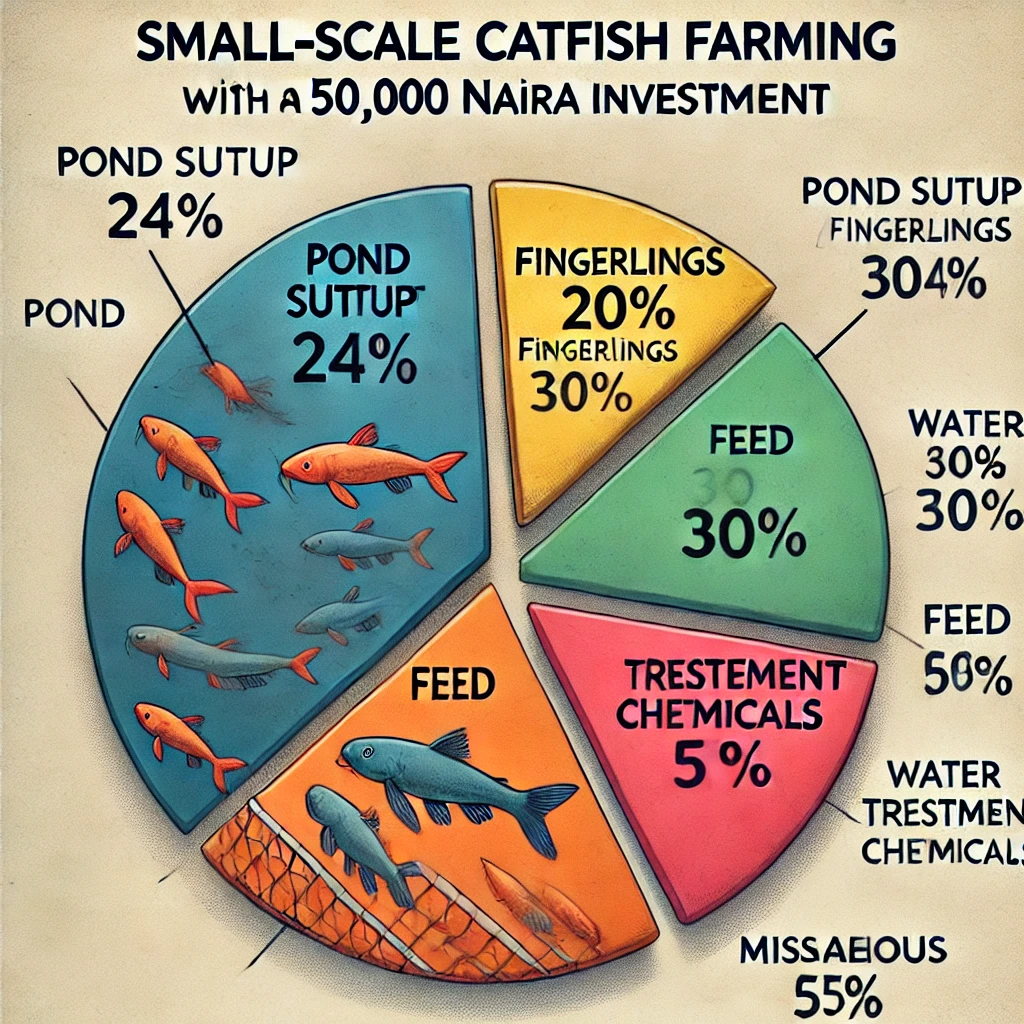Welcome back to your comprehensive, hands-on guide to catfish farming in Nigeria! This is Adeyemi, your dedicated tutor, and together, we will dive deep into every aspect of small-scale catfish farming. I’ll take you step-by-step, using charts, illustrations, and clear explanations to ensure you fully understand the process. By the end of this guide, you will not only know how to farm catfish, but you’ll also have the confidence to grow your farm into a thriving business that generates millions!

1. Introduction with Adeyemi – Your Mentor on This Journey
I’m Adeyemi, and I’m thrilled to be your guide. This is not just any ordinary guide—it’s a personalized course designed to equip you with the knowledge, skills, and confidence to make millions from small-scale catfish farming. We’ll cover everything from startup costs to scientific terms, ensuring you fully understand every step of the process.
Throughout this course, I’ll be using pictorial illustrations, scientific terms, and charts to help you visualize what you’re learning. Let’s get started!
Why Catfish Farming?
Catfish farming is a lucrative venture in Nigeria due to the high demand for fish protein. With minimal startup capital, you can grow a business that not only sustains you but also contributes to food security.
Success Story: From Backyard to Millions
“I started my catfish farm in my backyard with just a few thousand naira. Today, it’s a thriving business generating millions annually.” – Adeyemi

2. Understanding Catfish Biology
To farm catfish effectively, you need to understand their biology.
Catfish is a versatile fish that grows quickly, requires minimal input, and has a high market demand in Nigeria. It’s an ideal choice for small-scale farmers because you can farm it in small spaces like your backyard.
Here’s a pie chart showing the cost distribution in typical small-scale catfish farming:
The Science Behind Catfish Farming
Let’s get scientific! Here are a few important terms you need to know:
- Aquaculture: The farming of fish and other aquatic organisms. In your case, this means raising catfish in a controlled environment.
- Fingerlings: These are young catfish, usually between 2-3 months old, that you’ll start with. Fingerlings are crucial because they determine the growth and yield of your farm.
- pH Level: A measure of how acidic or basic the water is. Catfish thrive in water with a pH of 6.5–7.5. We’ll learn how to control this in the water management section.
Scientific Terms Explained
- Aquaculture: The farming of aquatic organisms like fish, crustaceans, mollusks, and aquatic plants.
- Fingerlings: Young fish that have developed scales and working fins, typically measuring 5-10 cm.
- Dissolved Oxygen (DO): The amount of oxygen present in water, essential for fish survival.
- pH Level: A measure of how acidic or alkaline the water is, ranging from 0-14.
Life Cycle of Catfish
Understanding the life cycle helps in managing growth stages effectively.
- Eggs
- Larvae
- Fry
- Fingerlings
- Juveniles
- Adults
3. Conducting Market Research – Know Your Audience
Who Are Your Customers?
To succeed in any business, you must understand your target market. In catfish farming, your potential customers include:
- Households: People looking for fresh fish for their meals.
- Restaurants and Hotels: High demand for fresh catfish for dishes like grilled catfish or catfish pepper soup.
- Event Caterers: For large quantities of catfish at weddings, parties, and events.
Market Trends and Insights
Here’s an important insight: demand for catfish spikes during festive periods. Use this information to plan your harvest, ensuring your fish are ready when demand is high.
4. The Backyard Setup – Starting Small and Smart
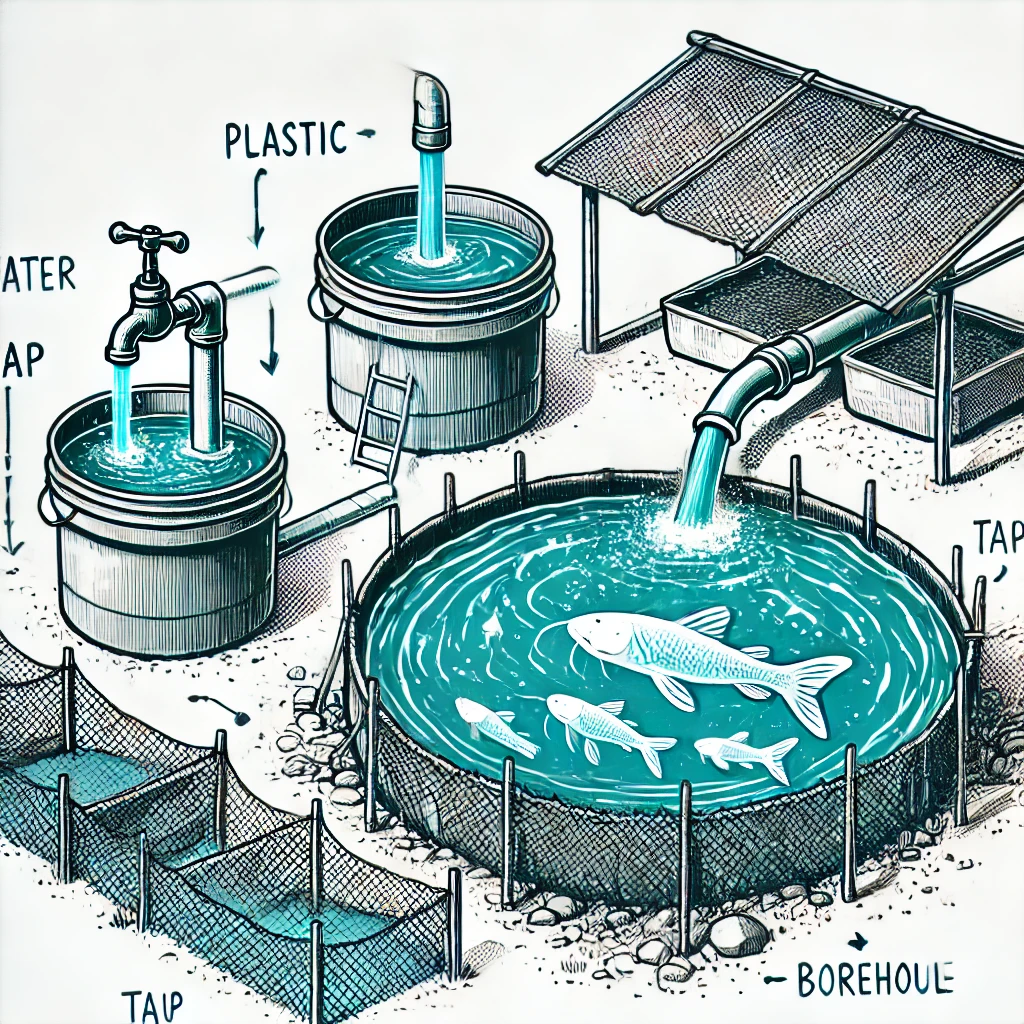
Building Your Pond
Even with a small space in your backyard, you can build an efficient pond. Here’s a pictorial illustration of a basic setup for a small-scale catfish farm:
You can use:
- Plastic tanks: Affordable and easy to maintain.
- Earthen ponds: For those with slightly more space.
Water Chemistry and Management
Water management is critical for the health of your fish. Here’s where the science comes in:
- Dissolved Oxygen (DO): This is the amount of oxygen available in water for the fish. Ensure your water is well-aerated. Low oxygen levels can slow fish growth and even lead to death.
- pH Management: Use lime to regulate the pH of the water. Regular testing ensures your pond stays within the optimal range (6.5–7.5).
Fish Health and Disease Control
Catfish are hardy but can be susceptible to diseases like bacterial infections. Use potassium permanganate to treat your water and prevent infections. Also, maintain cleanliness in the pond to avoid build-up of harmful bacteria.
5. 50,000 Naira Cost Breakdown with Adeyemi’s Financial Strategy
I know you’re working on a budget, so here’s a cost breakdown that will allow you to start smart with 50,000 Naira:
| Item | Cost (Naira) |
|---|---|
| Plastic Tanks (used or secondhand) | 12,000 |
| Fingerlings (100-150 pieces) | 10,000 |
| Feed (3-4 months) | 15,000 |
| Water and Utilities | 5,000 |
| Chemicals (lime, salt) | 2,500 |
| Miscellaneous | 2,500 |
| Total | 50,000 |
- Adeyemi’s Tip: Start with one tank and reinvest your profits. Expanding gradually will prevent overextending your resources.
Detailed Cost Breakdown
| Item | Cost (Naira) |
|---|---|
| Pond Construction | |
| – Tarpaulin Pond Setup | 12,000 |
| Fingerlings (150 pieces @ N50) | 7,500 |
| Feed | |
| – Starter Feed (0-1 month) | 5,000 |
| – Grower Feed (2-4 months) | 7,000 |
| Water Treatment Chemicals | 3,000 |
| Equipment | |
| – Nets, Buckets, etc. | 2,500 |
| Miscellaneous | 3,000 |
| Total | 40,000 |
| Contingency | 10,000 |
| Grand Total | 50,000 |
Pie Chart Representation
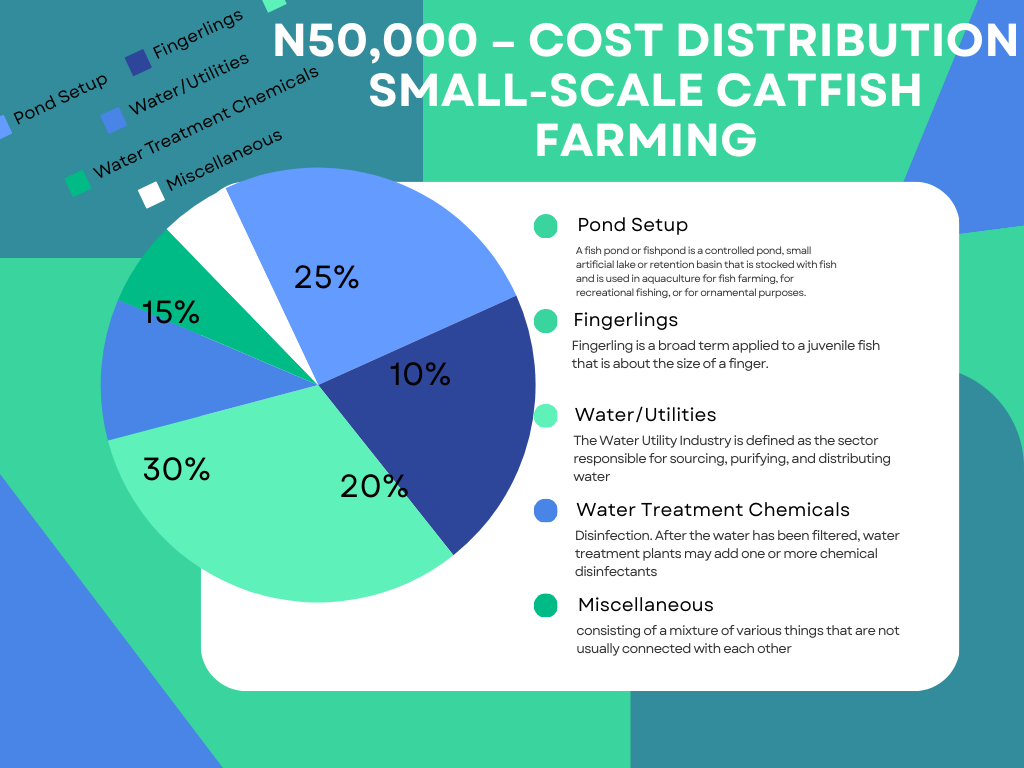
6. Selecting Quality Fingerlings
Recognizing Healthy Fingerlings
- Active swimming
- No visible deformities
- Uniform size
Reputable Suppliers
Purchase from certified hatcheries to ensure quality stock.
7. Feeding Practices
Nutritional Requirements
Nutrition Basics for Catfish
For rapid growth, catfish need a diet rich in protein. Commercial feed is great, but you can reduce costs with homemade alternatives.
- Protein: The most important nutrient for growth. Catfish need 30-35% protein in their diet.
- Fats and Carbohydrates: Provide energy for your fish.
Here’s a bar chart showing the nutritional breakdown of an ideal catfish feed:
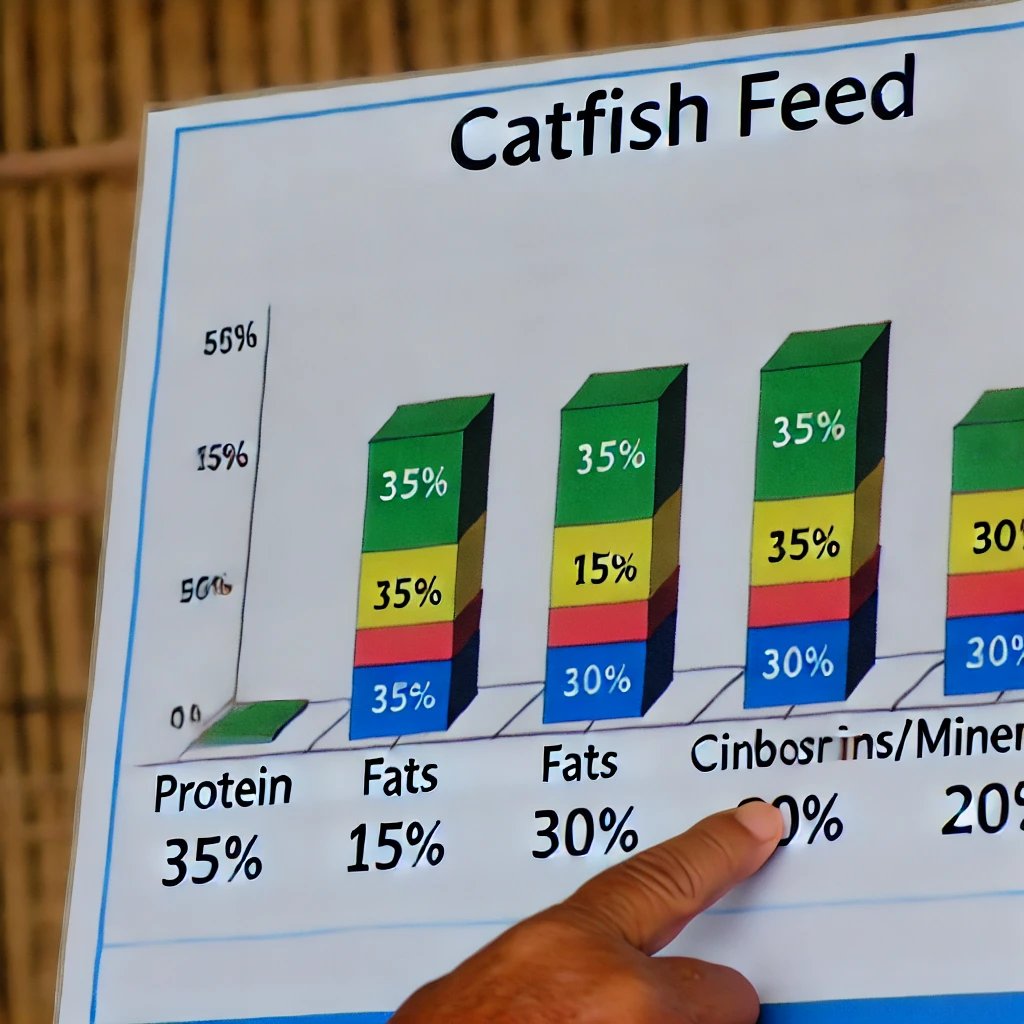
Homemade and Local Feed Options
- Groundnut cake: Rich in protein, it’s a cheaper alternative to fishmeal.
- Cassava peels: These can be processed and used to supplement their diet.
- Maggots and Earthworms: High in protein and free if you can cultivate them yourself.
Catfish require:
- Proteins: For growth (35-40% in feed)
- Fats: Energy source
- Carbohydrates: Additional energy
- Vitamins and Minerals: For overall health
Alternative and Affordable Feeds
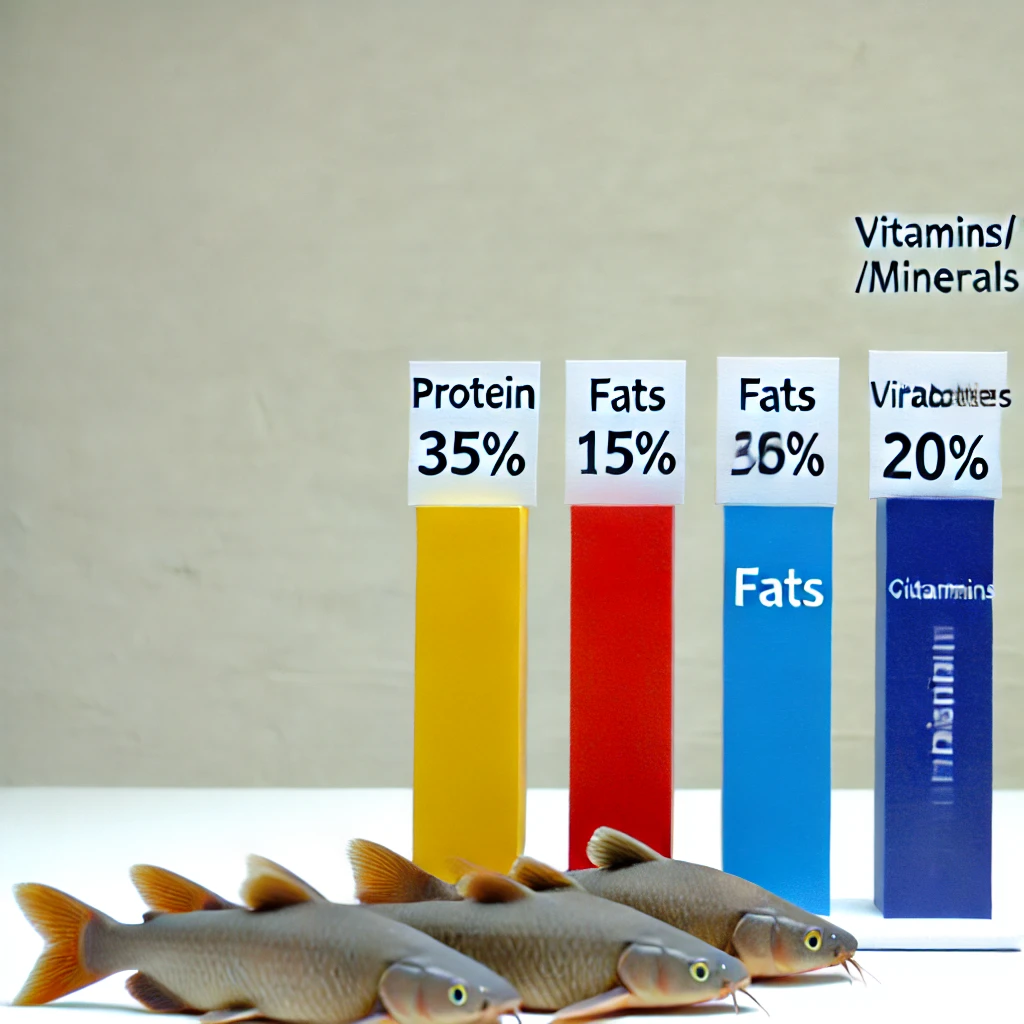
- Local Feed Ingredients: Cassava peels, maize, soybean meal.
- Formulating Homemade Feed
Simple Feed Formula
- 50% Ground maize
- 20% Soybean meal
- 20% Fishmeal
- 10% Cassava flour
Mix thoroughly and pelletize.
8. Water Quality Management
Essential Water Parameters
- Dissolved Oxygen (DO): Above 5 mg/L
- pH Level: Between 6.5 and 7.5
- Temperature: 26°C – 29°C
Minerals and Their Functions
- Lime (Calcium Carbonate): Stabilizes pH.
- Salt (Sodium Chloride): Helps osmoregulation and stress reduction.
- Potassium Permanganate: Used for treating bacterial infections.
9. Health Management
Common Diseases and Prevention
- Fungal Infections: Prevent by maintaining good water quality.
- Parasitic Infestations: Use salt treatments.
- Bacterial Diseases: Regular pond disinfection.
Signs of Healthy vs. Unhealthy Fish
Healthy Fish:
- Active movement
- Clear eyes
- Smooth skin
Unhealthy Fish:
- Lethargy
- Discolored spots
- Erratic swimming
10. Financial Management
Record Keeping
- Income Ledger: Sales records.
- Expense Ledger: Feed, utilities, maintenance.
- Stock Records: Number of fish, mortality rates.
Budgeting and Financial Tracking
Use a simple accounting system to keep track of your expenses, sales, and profits. You can even start with a notebook or Excel sheet. This will help you understand your cash flow and make informed decisions about when to expand.
Cash Flow Management
Here’s a line chart illustrating how you should manage your cash flow over time:
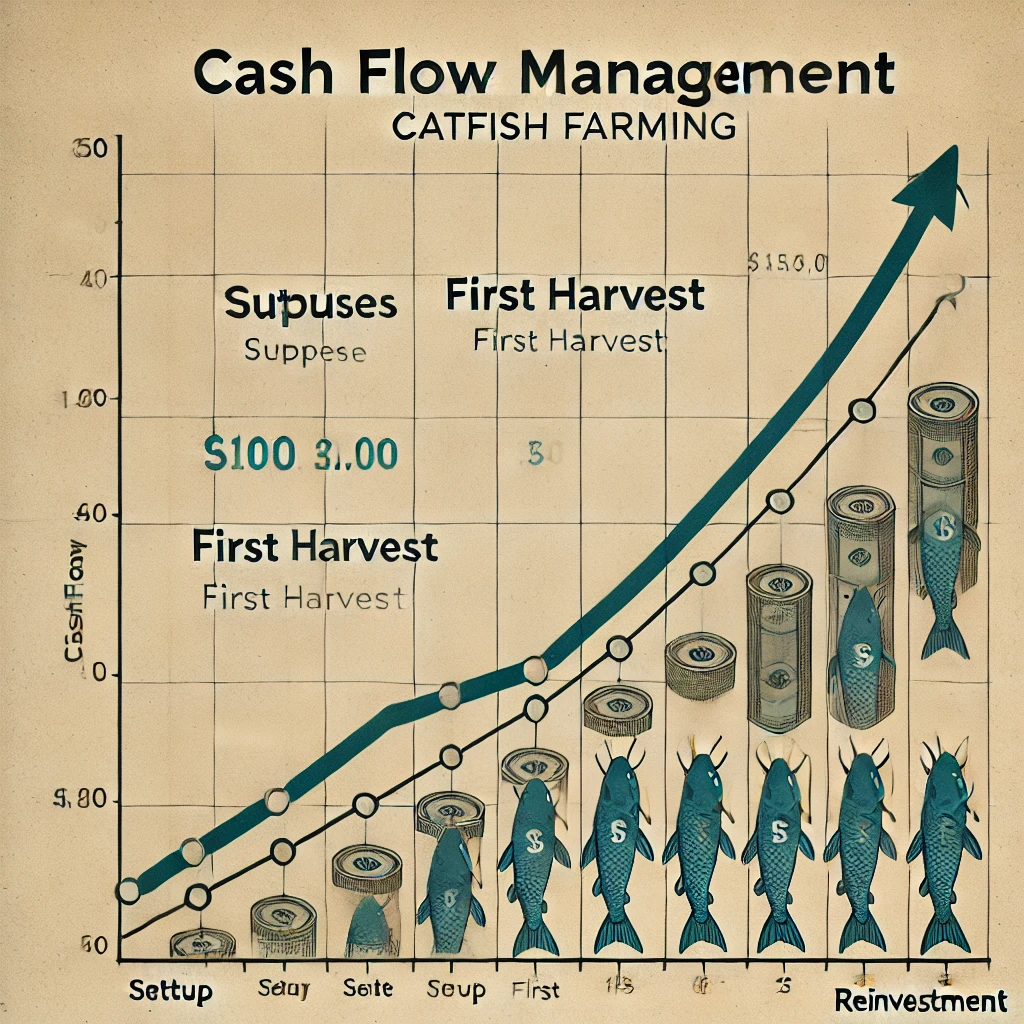
You’ll notice that your initial expenses are high, but as your fish grow and you begin selling, cash flow improves.
Profit Calculation
Projected Revenue:
- Selling 150 mature catfish at N700 each = N105,000
Projected Profit:
- Revenue (N105,000) – Total Cost (N50,000) = N55,000
Scaling Your Business
- Reinvest profits to purchase more fingerlings.
- Expand pond capacity.
- Upgrade equipment.
11. Marketing Strategies
Pricing Your Catfish
- Consider market rates.
- Offer competitive but profitable prices.
Promotional Techniques
- Social Media: Create a Facebook or Instagram page.
- Referrals: Encourage satisfied customers to refer others.
- Bulk Discounts: Attract larger buyers.
Building Customer Relationships
- Consistent quality supply.
- Good customer service.
- Reliable delivery options.
Building a Brand
Branding is key to standing out in the market. Name your farm and create a simple logo. Even small farms can benefit from strong branding—it helps people remember you.
Digital and Traditional Sales Channels
- Social Media Marketing: Use Instagram and Facebook to showcase your farm and attract buyers.
- Direct Sales: Sell directly to households, restaurants, and supermarkets. Offering discounts on bulk purchases is a great way to build long-term relationships.
12. Conclusion
Adeyemi’s Final Advice
Starting small doesn’t mean your profits will be small. With dedication, proper management, and the strategies outlined in this guide, you’re well on your way to building a successful catfish farming business.
Now that you’ve completed this guide, you’re well-equipped to start your own small-scale catfish farm and scale it into a profitable venture. With the tips, scientific methods, and financial management strategies I’ve shared, I’m confident you’ll succeed. Remember, start small, reinvest your profits, and continually improve your processes.
Good luck, and welcome to the world of successful catfish farming!
With every detail covered in this guide, you now have the tools to confidently begin your journey in catfish farming and make millions, just like me, Adeyemi!
Taking the Next Steps
- Action Plan: Begin setting up your pond this week.
- Continuous Learning: Stay updated with the latest aquaculture practices.
- Networking: Join local farming groups for support and opportunities.
Remember, every big enterprise started small. With this comprehensive guide, you’ve got all the tools you need to succeed. Trust in the process, stay committed, and soon you’ll be sharing your own success story.
Thank you for joining me on this journey. Wishing you prosperity and success in your catfish farming venture! – Adeyemi



